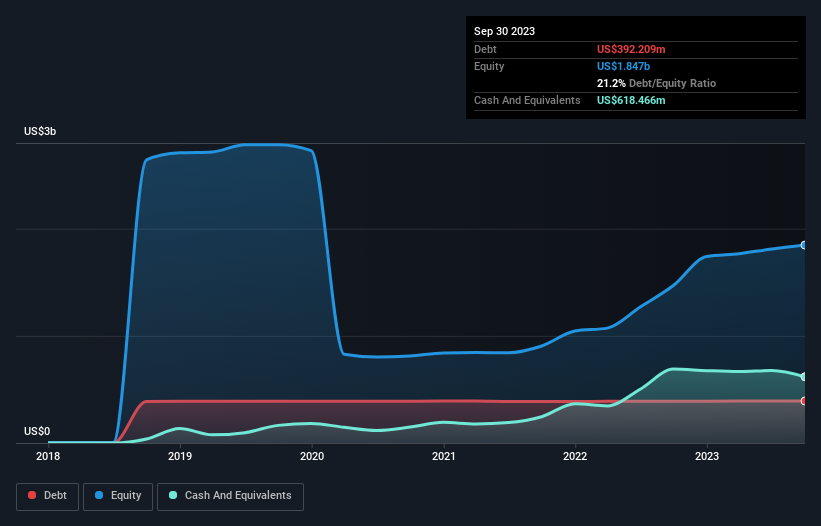The external fund manager backed by Berkshire Hathaway's Charlie Munger, Li Lu, makes no bones about it when he says 'The biggest investment risk is not the volatility of prices, but whether you will suffer a permanent loss of capital.' So it seems the smart money knows that debt - which is usually involved in bankruptcies - is a very important factor, when you assess how risky a company is. Importantly, Magnolia Oil & Gas Corporation (NYSE:MGY) does carry debt. But is this debt a concern to shareholders?
When Is Debt A Problem?
Generally speaking, debt only becomes a real problem when a company can't easily pay it off, either by raising capital or with its own cash flow. Part and parcel of capitalism is the process of 'creative destruction' where failed businesses are mercilessly liquidated by their bankers. While that is not too common, we often do see indebted companies permanently diluting shareholders because lenders force them to raise capital at a distressed price. By replacing dilution, though, debt can be an extremely good tool for businesses that need capital to invest in growth at high rates of return. The first thing to do when considering how much debt a business uses is to look at its cash and debt together.
See our latest analysis for Magnolia Oil & Gas
What Is Magnolia Oil & Gas's Net Debt?
As you can see below, Magnolia Oil & Gas had US$392.2m of debt, at September 2023, which is about the same as the year before. You can click the chart for greater detail. But on the other hand it also has US$618.5m in cash, leading to a US$226.3m net cash position.

A Look At Magnolia Oil & Gas' Liabilities
The latest balance sheet data shows that Magnolia Oil & Gas had liabilities of US$303.7m due within a year, and liabilities of US$501.6m falling due after that. Offsetting these obligations, it had cash of US$618.5m as well as receivables valued at US$186.8m due within 12 months. So these liquid assets roughly match the total liabilities.
Having regard to Magnolia Oil & Gas' size, it seems that its liquid assets are well balanced with its total liabilities. So it's very unlikely that the US$4.33b company is short on cash, but still worth keeping an eye on the balance sheet. Despite its noteworthy liabilities, Magnolia Oil & Gas boasts net cash, so it's fair to say it does not have a heavy debt load!
The modesty of its debt load may become crucial for Magnolia Oil & Gas if management cannot prevent a repeat of the 45% cut to EBIT over the last year. When a company sees its earnings tank, it can sometimes find its relationships with its lenders turn sour. When analysing debt levels, the balance sheet is the obvious place to start. But ultimately the future profitability of the business will decide if Magnolia Oil & Gas can strengthen its balance sheet over time. So if you're focused on the future you can check out this free report showing analyst profit forecasts.
Finally, a business needs free cash flow to pay off debt; accounting profits just don't cut it. While Magnolia Oil & Gas has net cash on its balance sheet, it's still worth taking a look at its ability to convert earnings before interest and tax (EBIT) to free cash flow, to help us understand how quickly it is building (or eroding) that cash balance. During the last three years, Magnolia Oil & Gas produced sturdy free cash flow equating to 79% of its EBIT, about what we'd expect. This cold hard cash means it can reduce its debt when it wants to.
Summing Up
While it is always sensible to look at a company's total liabilities, it is very reassuring that Magnolia Oil & Gas has US$226.3m in net cash. The cherry on top was that in converted 79% of that EBIT to free cash flow, bringing in US$381m. So we are not troubled with Magnolia Oil & Gas's debt use. The balance sheet is clearly the area to focus on when you are analysing debt. However, not all investment risk resides within the balance sheet - far from it. For instance, we've identified 2 warning signs for Magnolia Oil & Gas (1 is a bit unpleasant) you should be aware of.
Of course, if you're the type of investor who prefers buying stocks without the burden of debt, then don't hesitate to discover our exclusive list of net cash growth stocks, today.
New: Manage All Your Stock Portfolios in One Place
We've created the ultimate portfolio companion for stock investors, and it's free.
• Connect an unlimited number of Portfolios and see your total in one currency
• Be alerted to new Warning Signs or Risks via email or mobile
• Track the Fair Value of your stocks
Have feedback on this article? Concerned about the content? Get in touch with us directly. Alternatively, email editorial-team (at) simplywallst.com.
This article by Simply Wall St is general in nature. We provide commentary based on historical data and analyst forecasts only using an unbiased methodology and our articles are not intended to be financial advice. It does not constitute a recommendation to buy or sell any stock, and does not take account of your objectives, or your financial situation. We aim to bring you long-term focused analysis driven by fundamental data. Note that our analysis may not factor in the latest price-sensitive company announcements or qualitative material. Simply Wall St has no position in any stocks mentioned.
About NYSE:MGY
Magnolia Oil & Gas
An independent oil and natural gas company, engages in the acquisition, development, exploration, and production of oil, natural gas, and natural gas liquids reserves in the United States.
Excellent balance sheet and good value.
Similar Companies
Market Insights
Community Narratives



